|
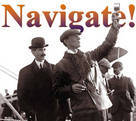
 Up
Up 
 Unbelievable
Unbelievable
Flying Objects

(You are here.)



  Need
to Need
to
find your
bearings?
Try
these
navigation aids:
If
this is your first
visit, please stop by:
Something
to share?
Please:



|
|
Available in Française, Español, Português, Deutsch, Россию,
中文,
日本, and others.
 efore
the Wright brothers, a good many aspiring aviators thought they had
stumbled on the secret of flight and built flying machines to test their
ideas. None of these were successful, of course, and quite a few of them
were so far off base that, looking back from the advantage of our
21rst-century viewpoint, we wonder how the builders could possibly have
thought they might fly. Even after the Wright brothers showed the world
how to build an airplane, strange contraptions of dubious airworthiness
continued to appear. We have collected a few of these here for your
enjoyment and edification. efore
the Wright brothers, a good many aspiring aviators thought they had
stumbled on the secret of flight and built flying machines to test their
ideas. None of these were successful, of course, and quite a few of them
were so far off base that, looking back from the advantage of our
21rst-century viewpoint, we wonder how the builders could possibly have
thought they might fly. Even after the Wright brothers showed the world
how to build an airplane, strange contraptions of dubious airworthiness
continued to appear. We have collected a few of these here for your
enjoyment and edification. |
|
|


 |
Monoplanes
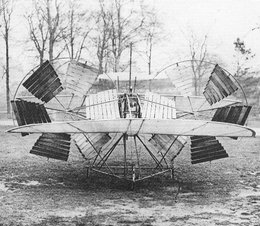
1875 "Aerial Steamer" -- a tandem-wing monoplane
by Thomas Moy. It was unmanned and traveled in a wide circle,
tethered to central post. During one demonstration, its 3-hp engine
lifted the 120-lb. craft 6 inches off the ground.
|
|
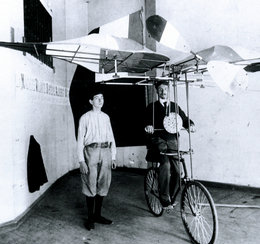
In 1904, inventor Schmutz tried to cycle aloft in
this pedal-powered airplane. He failed, but five years later "aviettes"
-- bicycles with glider wings -- would become a brief fad in Europe
and America as cyclists completed to make the longest hop-flights.
|
|
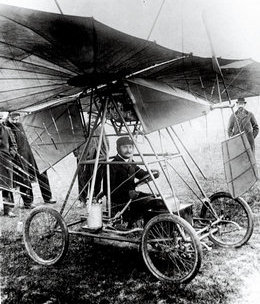
In 1906, Trajan Vuia made 11 hops in this tractor
monoplane. Although it did not achieve sustained flight, the
aircraft influenced successful designs that came afterwards.
|
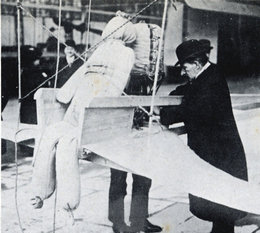
An idea ahead of its time -- this ejection seat
was first tested in 1910 on a monoplane. It worked -- sort of. But
it was completely impractical for a biplane -- the pilot would hit
the top wing.
|
|
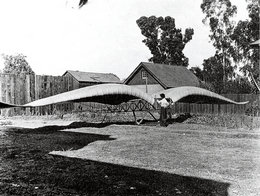
The 1910 Burke "Seagull" had spectacularly curved
wings patterned after its namesake. |
|

This imitation of nature came to naught, however.
The Seagull refused to leave the ground. |
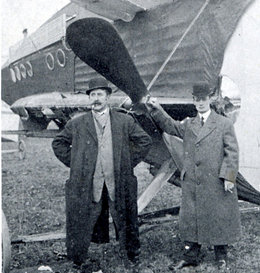
The 1910 Cooley Airship looked more like a yacht
than an aircraft.
|
|
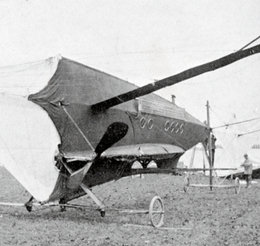
In fact, the only feature that marked the Cooley
Airship as an airplane and not a boat was that it had huge wings. It
flew about as well as a boat, too.
|
|
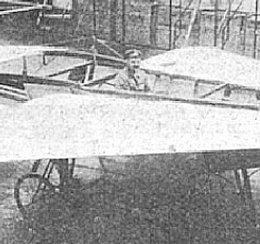
The 1910 Fleche may have been the first "variable
wing" airplane. The wings folded out for for flight, in for storage.
It spent most of its time in storage.
|
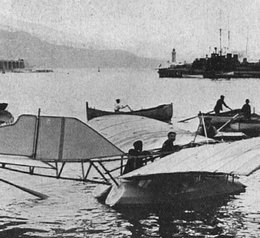
This 1910 "Hydroaeroplane" was meant to take off from
and land on the water. It did neither.
|
|
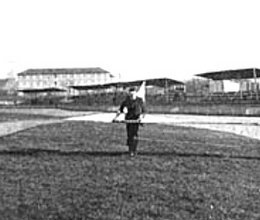
The Demouveaux was more of a parachute than an
airplane -- four wings sprouted from a diamond shape hub in which
the pilot hung and watched his life flash before his eyes. It was
apparently meant to float down on the wind much the same as maple
seeds.
|
|
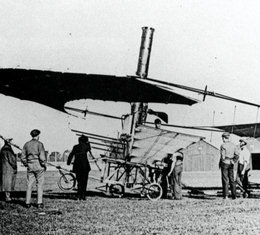
Another idea before its time -- the huge
chimney-looking thing on the 1911 McCormick-Dearing "Paraplane" was
actually a ballistic parachute to save the pilot from crashing. It
was never used since the plane refused to fly.
|

The 1910 Wyndham was sported tandem delta-shaped
wings.
|
|
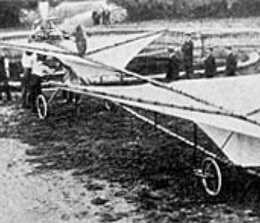
The wings, however, would not support the
aircraft. It never flew.
|
|
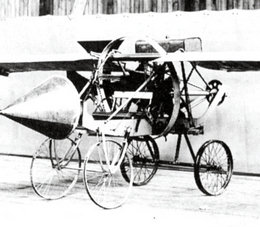
Looking like a winged rocket, this tiny monoplane
by an unknown builder is displayed against what seem to be Wright
biplane wings.
|
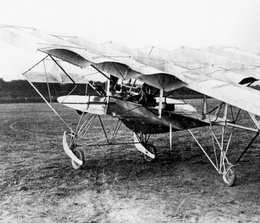
The corrugated wing of this craft was probably
intended to add strength. Unfortunately, it did not add enough lift.
|
|
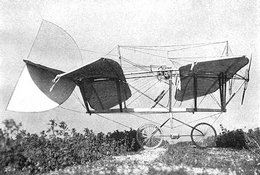
Although John J. Montgomery built some of the earliest
successful gliders (perhaps as early as 1883), this -- his
one powered airplane built in 1910 -- was not. Although
based on a proven glider design, it would not fly.
Montgomery went back to building successful gliders in 1911.
|
|
|
|
Biplanes
and Triplanes
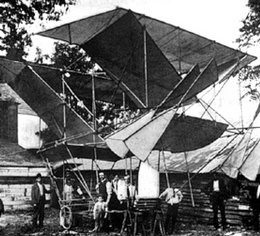
In 1905, New York lawyer Israel Ludlow tried
and failed to fly this biplane. It climbed into the air briefly, but
then crashed.
|
|
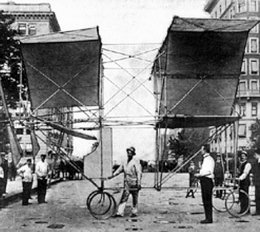
A side view of Ludlow's 1905 airplane. The man
standing inside the aircraft in the center of the photo is Hamilton,
the unfortunate pilot. Israel Ludlow is to the right in a white
shirt.
|
|
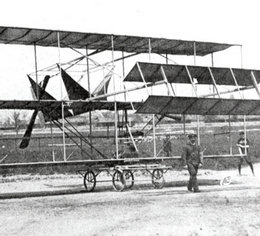
Morris Bokor's triplane actually won a $500 prize
from the Aeronautic Society of New York in 1909 for excellence of
construction, even though it failed to fly.
|
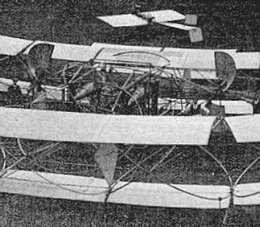
The 1910 Seddon was a huge tandem biplane that
from the side looked like a collection of overgrown hula-hoops.
Almost every structural part on the aircraft was bent, many of them
in a full circle.
|
|
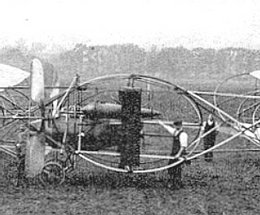
Seddon's idea, apparently, was that the bent
wooden parts would act like springs, absorbing the impact of a crash
of a hard landing with little damage to the airframe. The concept
was never proved since the aircraft never flew.
|
|
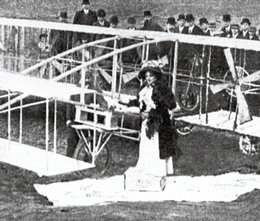
After building a helicopter that refused to fly,
the energetic Wilbur R. Kimball built this biplane the very next
year, in 1909. Its eight propellers, turned by a single engine,
failed to lift it off the ground.
|
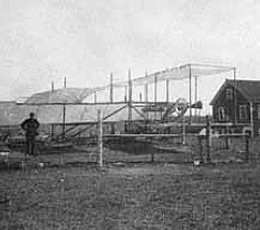
Gustave Whitehead claimed to have flown a small
monoplane in 1901 and 1902. But instead of building on this supposed success,
he made a series of gliders, then began building a biplane in 1906
|
|
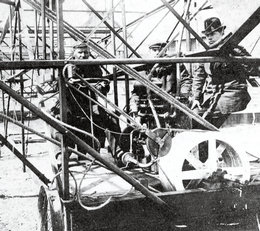
Whitehead's partner in this venture was Stanley Y.
Beach, son of the editor of Scientific American magazine, who
contributed $10,000. The biplane was completed in 1908, but never
flew.
|
|
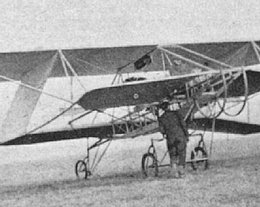
The 1910 Huntington biplane showed many odd angles
and curves -- but no tendency to fly.
|
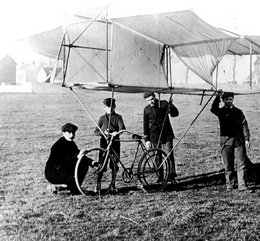
The 1909 Puissex was yet another attempt to cylce
into the air. Initially built as an "aviette" -- a bicycle with
glider wings -- the builder added small engine to see how far it
would go. It went nowhere.
|
|
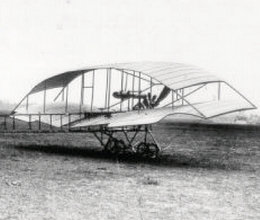
We're not quite sure what the curved top wing of
the Sloan "Bi-Curve" was supposed to do for the flight
characteristics of this 1910 aircraft. Apparently, very little. It
had no flight characteristics.
|
|
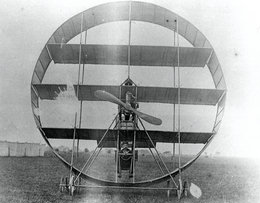
The 1911 Geary Circular Triplane was an updated
version of d'Equevilly's multi-wing
design which produced exactly the same disappointing results.
|
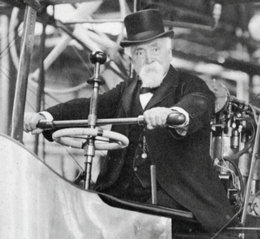
Hiram Maxim, the inventor of the machine gun, was
also an enthusiastic (if unsuccessful) aircraft designer.
|
|
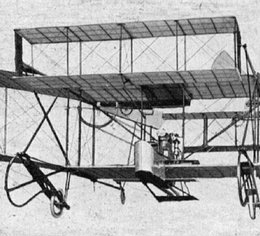
In the 1890s, Maxim had built a huge biplane "test
rig" that made an unplanned flight, followed by an unplanned crash.
In 1910, he tried again with yet another mammoth biplane with a
wingspan approaching 100 ft.
|
|
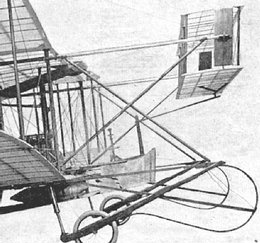
Maxim's Mammoth even had "bumpers" on the front to
absorb the impact of a crash landing. There was no need. It never
crashed -- it never even left the ground.
|
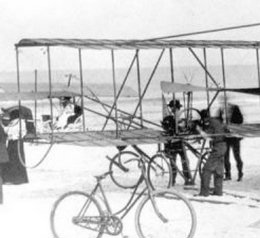
Yet another reincarnation of an overly optimistic
design -- a bicycle airplane.
|
|
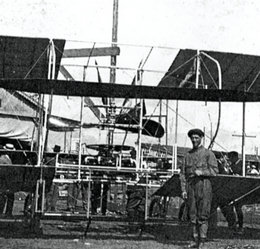
This biplane was built by Franz Miller of Turin,
Italy for aspiring pilot Mario Cobianchi. It was among the first
airplanes to attempt to fly in Italy.
|
|
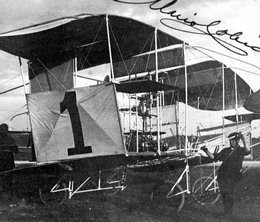
Unfortunately, it did not fly, although it managed
a brief bounce into the air. That was as close to flight at Mario
got.
|
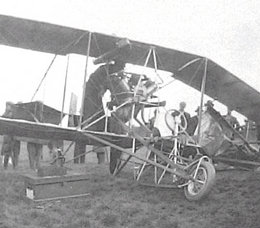
If you can't get off the ground with a bicycle,
maybe a motorcycle will help. This apparently was the theory behind
the "Negplane."
|
|
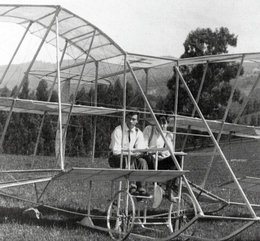
This flimsy-looking triplane was apparently meant
to be peddled into the air by two pilots – pioneer aviations'
answer to the tandem bicycle.
|
|
|
|
Multi-Winged Craft
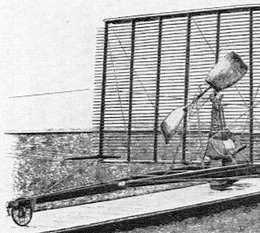
In 1893, Horatio Phillips tested this unmanned "venetian
blind" aircraft tethered to a circular track. The back wheels rose 2
to 3 feet above the ground, but the front wheels did not lift off.
|
|
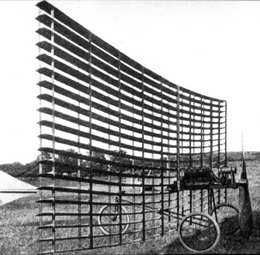
If at first you don't succeed...Horatio Philips
tried again in 1904 gas-powered multi-wing machine. It hopped
briefly, but the wings collapsed before it achieved true flight.
|
|
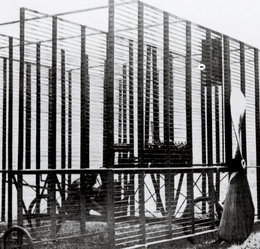
And again. In 1907, Horatio Phillips crammed a buh-zillion
slender wings in four sturdy frames. This time, it worked -- he flew
about 500 feet, and that was enough for him.
|
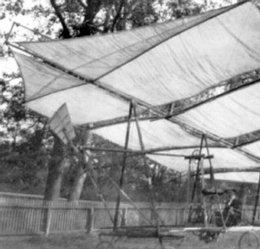
It's hard to tell whether this 1908 flying machine
has multiple wings or just a bunch of bed sheets stretched on a
single frame. Needless to say, it didn't fly.
|
|
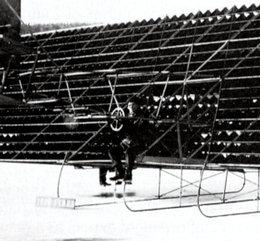
Even great minds occasionally produce bad ideas.
Alexander Graham Bell, inventor of the telephone, was convinced that
this 900-lb. "tetrahedral" box kite would make a good airplane.
|
|
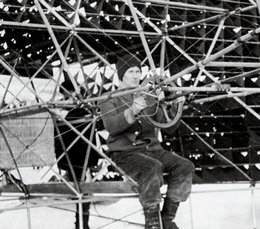
Bell was, of course, wrong. Pilot J.A.D. McCurdy
could not coax it off the ice of the lake that he used as a runway.
It finally did fly in 1912 in a much modified form just so Bell
could "show the skeptics."
|
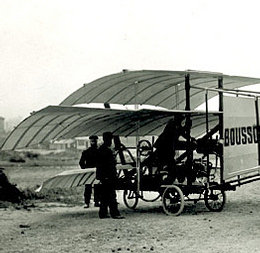
The 1908 Bousson had
several tiers of wings which could not sustain it in flight
for more than brief hops
|
|
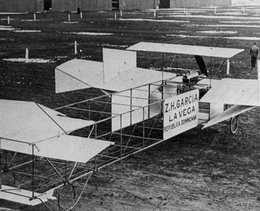
The 1911 Garcia "Polyplane" looked for all the
world as if the builder had stood back from the fuselage and threw
wings at it, letting them stick wherever they landed.
|
|
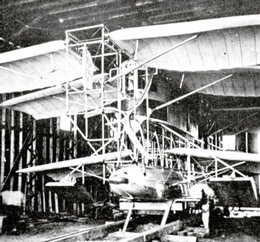
The 1913 Air Yacht offered passengers every
amenity except aerial transportation.
|
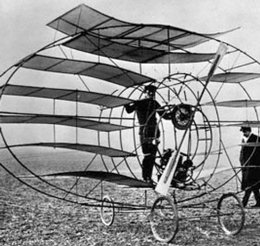
In 1908, the Marquis d'Equevilly designed an
aircraft that looked a great deal like a vegetable shredder and flew
almost as well.
|
|
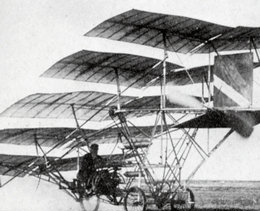
Jerome S. Zerbe attempted to fly this tiered
collection of wings in Sand Diego in 1910. It hit a pothole in the
field and collapsed.
|
|
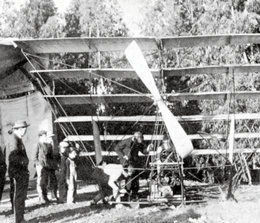
Undeterred, Zerbe built this new, improved model
-- which also failed to fly.
|
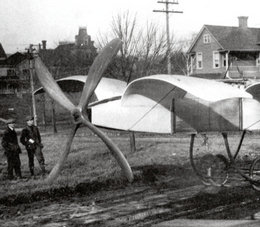
The 1912 Huntington, with six pairs of arched
wings looks impressive even if it never flew.
|
|
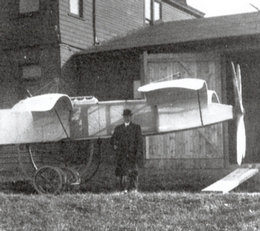
In 1914, Huntington did manage to get a smaller
plane off the ground with only two pairs of wings.
|
|
|
|
|
Flapping
Wings
|
|
Helicopters
|
What the
Heck?
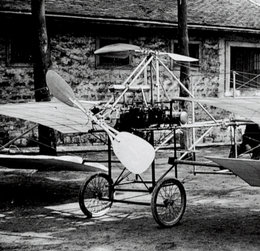
In 1908, aircraft builder Bertin added a
freely-rotating horizontal propeller to a biplane to give it
more lift. The "Bertin Autogyro" was not successful, though later
autogyros would be.
|
|
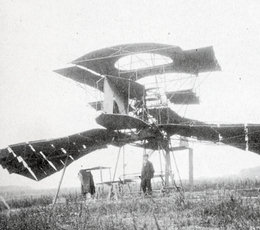
The 1910 Shultz, constructed of linen and bamboo,
required twelve years to build -- proof that you need more than
persistence to succeed in aviation.
|
|
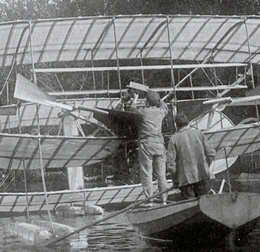
Although Louis Bleriot eventually became one of
the most successful pioneer aviators and airplane builders, he made
many false starts. This strange craft with tandem oval wings, built
in 1906, was his third unsuccessful aircraft.
|
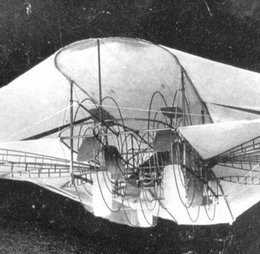
Built by Texas preacher Burrel Cannon, this
paddle-wheel biplane may have made a short hop of 160 feet in 1902.
Then again, it may have simply been lifted off the ground briefly by
the gusty breezes that blow over the plains surrounding Pittsburg,
TX. It never flew again until it was blown off a railroad car in
1904.
|
|
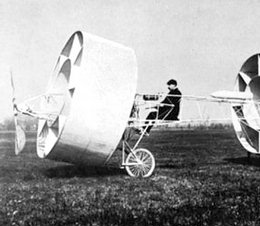
The drum-like wings of the Givaud were intended to
protect the pilot. They did their job admirably by preventing the
aircraft from leaving the ground.
|
|
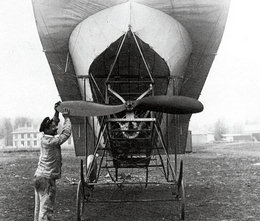
You have to wonder what the builder was thinking.
You might wonder if the builder was thinking at all.
|
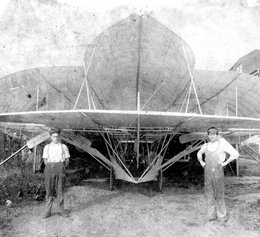
The craft behind these determined-looking builders
looks as if they might have borrowed a few ideas from the Ezekiel
Airship -- including its fondness for the ground.
|
|
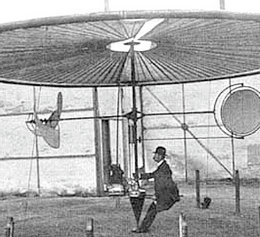
The Villard looked more like an umbrella than an
airplane.
|
|
|
|
|
|
|